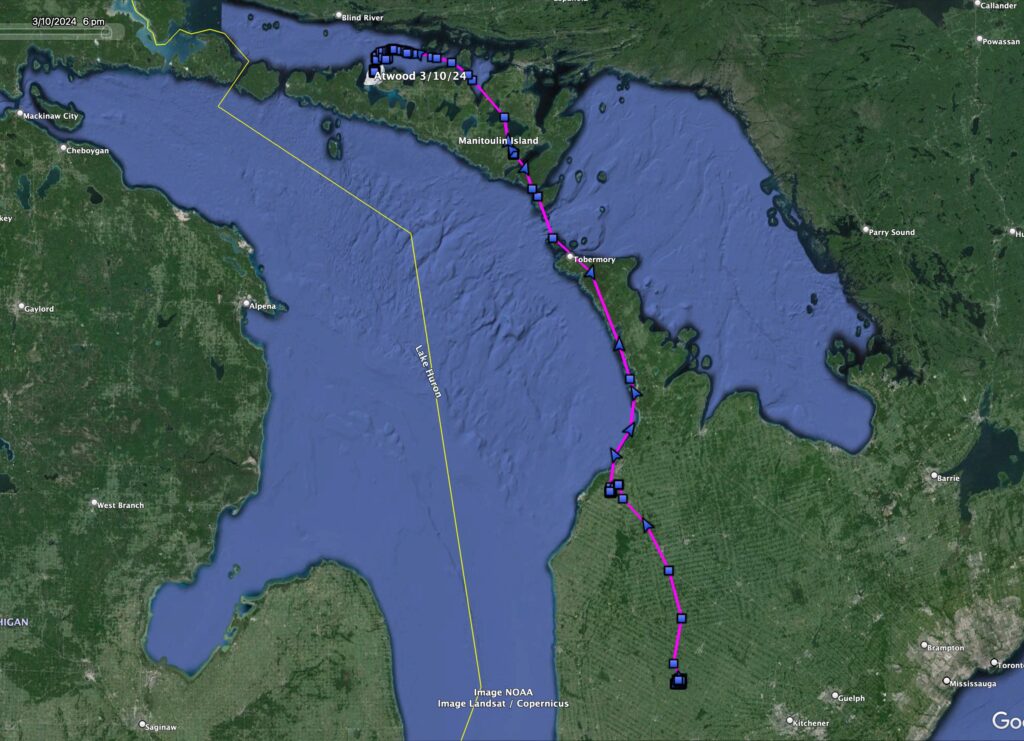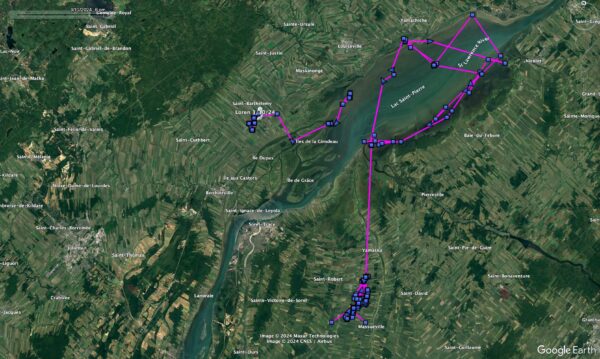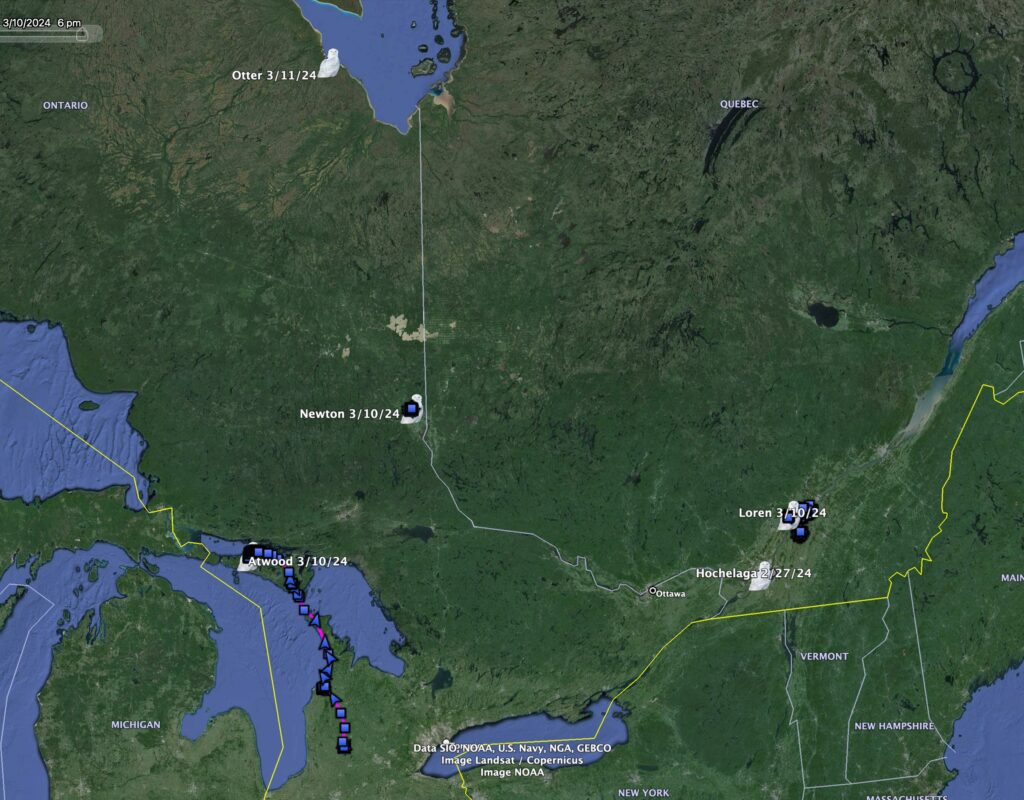
Atwood’s been on the move, leaving southern Ontario for Manitoulin Island. (©Project SNOWstorm and Google Earth)
The days are getting longer, and at least one of our tagged owls has started to head north — and that one, Atwood, is a bird whose locations we’d been masking because there was a bit more photographer activity in the area than we were entirely comfortable with. We also heard from an old veteran whom we assumed had remained north of cell range all winter, and have confirmed now that indeed he had.
After Atwood, an adult female, was tagged Feb. 25 in southern Ontario, we took the unusual step of masking her location and not publishing a tracking map. Even though the data on all our active maps is withheld for at least 24 hours, she was using a very small area and there was some concern about pressure from photographers, though no untoward behavior had been reported.
On March 5, however, Atwood upped stakes and moved north, migrating first to the edge of Lake Huron near Port Elgin, ON, then on March 7 continuing north up the Bruce Peninsula and over to Manitoulin Island, where she’s been ever since, spending most of her time recently on the ice-covered North Channel between the mainland and the island. We’ve enabled her tracking map, which you can find here.

Loren swapped sides of the St. Lawrence last week. (©Project SNOWstorm and Google Earth)
Loren, who had remained near Massueville, QC, on the south side of the St. Lawrence since being moved from the Montréal airport last month, has also been on the move. On March 6 she flew north to the river, and after several days along and on the frozen St. Lawrence she moved to the north shore, to another area that has been attracting both birders and photographers looking for snowy owls. (One birder has already reported her to eBird, which we appreciate.) Colleagues of ours in the area are monitoring the situation, and if we need to take her map offline for a while we’ll do so.
Newton, who wintered a good deal farther north in Ontario near Lake Timiskaming, hasn’t budged since his earlier jaunt up and back to James Bay. And Hochelaga, who has again wintered near the Montréal airport but whose transmitter has struggled with solar charging, hasn’t checked in since March 1. All we can do is hope he’s OK, and that whatever is interfering with his transmitter getting a good charge resolves itself, but I’ll confess to some unease.

Now he’s checking in via satellite, we can see that Otter (top) appears to have spent the winter along lower James Bay, much farther north than the rest of our cohort. (©Project SNOWstorm and Google Earth)
The other big news this week involves Otter, our old adult male first tagged in upstate New York in Jan. 2019 with a hybrid GSM (cell)/Argos satellite transmitter. Like all of our transmitters, the GSM side of the unit only sends data when it’s in cell range, while the satellite side is programmed to operate from March 1-Sept. 30. We watched his movements all summer in the Arctic, but when he last transmitted via Argos in late September he was just starting to head south. Otter never checked in via cell, so we assumed he was just wintering outside the cellular network, something he (like Hochelaga) had done in the past.
Once the calendar flipped to March, we began getting a small number of GPS locations from him every Monday as scheduled. Sure enough, Otter is currently on lower James Bay, about 27 km (17 miles) southeast of Fort Albany, a Cree First Nation community that maps of Canadian cell service suggests does not have cellular coverage. It’s unlikely he’ll find himself in cell range before heading back to the Arctic for the summer, but if he does — and there are a fair number of small communities along the west side of Hudson Bay that may provide a chance to connect — we might still get all of his backlogged data he’s been storing in his transmitter’s memory files for nearly a year. Otherwise we’ll have to wait until next winter and see if he comes farther south than he did this year. (Unfortunately, the Argos satellite locations don’t feed into the tracking maps we have, which are based on the GSM data, so Otter’s online map only goes up to April 2023 when he last headed north.)
I have to wonder how many others of our previously tagged owls may have done the same as Otter in this odd, frighteningly mild winter, and stayed well north of the cell network.


4 Comments on “On the Move (or Not)”
what a joy it is to read some news about those Snowies! Thank you for sharing. Recently I borrowed a dvd about Snowy Owls living tough off the Arctic tundra. I wanted to learn about these incredible, noble, resilient, ethereal birds that live in a treeless land harsh, rugged, unforgiving, months of dark and months of light, yet beautiful in its own way.
This is very good news for the SNOW’s. Thanks !
Thanks for the updates Scott. Good to hear from the Snowies!!! Been wondering about Otter, great that he checked in. Hopefully we will hear from Hochelaga before he heads north!
So enjoy the Snowy updates! And, brilliant that you mask locations when warranted. It seems many people today lead with their camera’s and in so doing, they forget/ignore the ethics of birding and/or those of wildlife photography.
And, I love that one of the birds is “Atwood”! I grew up in a town named Atwood in NE Colorado. It’s a very small farm town, still without a gas station or stoplight! Be safe Atwood!
Thanks for all you do to understand more about our magnificent Snowies!